Jack posed a question in his comment the other day and asked for more information about those two big gold keys in the coat of arms of Weil der Stadt. Crossed keys like that in general are the symbol of St. Peter in the Catholic church. The keys in the Weil der Stadt shield indicates the importance of the town’s Catholic Church, which is the Church of St. Peter and Paul.
A mention of that church leads neatly into my planned post for today, actually, because I want to talk a little about our visit to that very church. As I mentioned yesterday, the bell tower of that church is visible over the top of the city hall building. The church was rebuilt after the 30 Years War in the 1600s, but has been remodeled and redecorated over the centuries. There were a couple of noteworthy “modern” pieces inside that I took photos of (all the photos are in the gallery are the end of the post):
- A side altar to the Virgin Mary has a very modern-looking mosaic; the red “ornament” that Mary seems to be wearing around her neck almost looks 3-D, but it was really just part of the flat mosaic panel. A sign next to the panel indicates it was added to the church in 1943.
- The side altar in a different part of the church has Christ and the two thieves on their crosses, as it typically found in a Catholic church. However, atypically, all 3 figures have realistic hair attached to the statues. I also found the bloody wounds more gory than is typical for these kinds of statues. I didn’t see a date associated with these.
- A stained glass window that is off to one side depicts scenes from Christ’s life. It is considered the master work of a German artist named JoKarl Huber. Here’s a description of a panel that was quite controversial when the design was unveiled in 1940:… one panel of which shows the temptation scene from the gospel of Matthew, in which Satan offers all the realms of the world to Jesus, if he will only worship Satan. Satan bears the unmistakable features of Adolf Hitler. This window is considered Huber’s masterwork. — from http://www.freebase.com/m/028577h
But one of the most interesting things was what was happening when we walked into the church. There was no church service going on, but someone was up in the choir loft, rehearsing a number on the big pipe organ. It was a striking number that seemed to evoke the sounds of the carillon tune played by the Big Ben Clock in London. The sound and song were quite impressive. After the organist finished playing, he came down and started to put pieces of paper in each pew. Chris went up and asked the organist what the song had been, and it turned out not to have been accidental that it sounded sort of like that Big Ben Carillon, as in fact the piece is called Carillon de Westminster. It was written by a late 19th-early 20th century French composer and organist, Louis Vierne, who from birth was nearly blind, but was a musical prodigy who played the piano at the age of two.
Vierne actually turns out to have quite an interesting life history, at least according to Wikipedia. He was appointed to the prestigious position of being the official organist of Notre Dame in Paris in 1900 … but the organ was in such a state of disrepair at the time it couldn’t really be played. To raise money, he gave a series of concerts in the U.S., including playing recitals on the Wanamaker Organ at the Wanamaker department store in Philadelphia. The Wanamaker Organ was (and still is) the largest operational pipe organ in the world; it’s still on the same spot, although the department store is now a Macy’s.
Quick aside: I remember going over to Wanamaker’s many a time at Christmas when I was a kid to see a special light show that went along with a Christmastime performance on that organ Wanamaker’s. Thanks, Mom, for taking me over there!
Anyway, Vierne successfully raised the money to get the organ at the Notre Dame Cathedral repaired, and was eventually able to take up his post there, playing there for years, even re-learning how to play after losing the use of one leg. He suffered from ill-health at many times over the years, and his oft-stated desire was to die while playing the organ in Notre Dame. On June 2, 1937, that’s exactly what happened:
Vierne suffered either a stroke or a heart attack (eyewitness reports differ) while giving his 1750th organ recital at Notre-Dame de Paris on the evening of 2 June 1937. He had completed the main concert, which members of the audience said showed him at his full powers—”as well as he has ever played.” Directly after he had finished playing his “Stele pour un enfant defunt” from his ‘Triptyque’ Op 58, the closing section was to be two improvisations on submitted themes. He read the first theme in Braille, then selected the stops he would use for the improvisation. He suddenly pitched forward, and fell off the bench as his foot hit the low “E” pedal of the organ. He lost consciousness as the single note echoed throughout the church. He had thus fulfilled his oft-stated lifelong dream—to die at the console of the great organ of Notre-Dame. — From the Wikipedia entry for Louis Vierne
Anyway, hearing his Carillon de Westminster as we walked around the Church of St. Peter and St. Paul in Weil der Stadt was really something. It’s quite a powerful piece of music, particularly if you hear it reverberate around a nearly-empty church as the organist gets his final rehearsal done before the concert.
BTW, those pieces of paper the organist was putting in the pews was actually the program with a list of all the songs to be played at the concert that night. It was a concert in honor of the 70th birthday of a man, who was presumably from Weil der Stadt. Each piece on the program was actually connected to the theme of the Carillon.
Now, there was a title for the concert given at the top of the program. It was apparently a birthday party and not an in memorium concert, which made the title of the concert a little puzzling. I can only suppose that the title was supposed to be ironic. You see, the title read: Wem der Stunde slägt?, which is used as the standard translation for the English phrase “For whom the bell tolls.” I’m not sure if that really suggests “Happy Birthday” in English, so here’s hoping there’s a different connotation to that phrase in German…
In any case, photos of the art in the church are below. Also, Chris found a clip on YouTube of someone playing the Carillon de Westminster; you can listen to it by clicking here.
Enjoy.
- Weil der Stadt City Hall with the tower of the Church of St. Peter and St. Paul behind
- Altar to the Virgin Mary with mosaic artwork
- Mosaic artwork – detail
- Statues on the crosses, each with hair
- Stained Glass window designed by JoKarl Huber
- Huber window with Jesus refusing the devil/Hitler

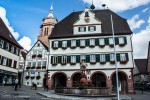
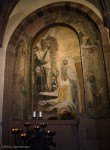
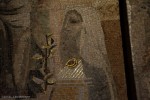
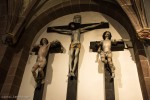
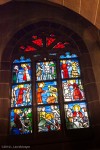
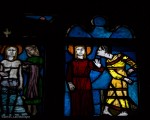
This is a wonderful story. I enjoyed taking you to see the light show, it was fun.